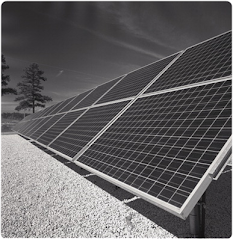
The Hubble Space Telescope is arguably one of the most successful NASA projects all time and is also arguably one of the most important tools yet invented.

Exciting times are ahead when NASA launches the next gen James Webb Telescope in 2014.

Hubble, in paricular Hubble Deep Field, returns images from some of the oldest parts of our known Universe and has been absolutely integral in helping to formulate and test theories about the cosmos, forces and history of the universe.

Plus the pictures are just awesome.

...and also another plus, like many objects that orbit the Earth, the hubble is Solar Panel Powered, with an Array of 2 x 25 ft panels.
Here is a youtube link to a wonderful documentary on the hubble
http://www.youtube.com/watch?v=SpkrVw_E6Nw
So Hubble is amazing, but it didn't require the kind of 'never before seen' international scientific cooperation that the International Space Station did / does. (15 Nations)

The international Space Station also uses solar arrays for electrical power supply. Some supplied by Russia, some from U.S. sources.

Youtube tour of the ISS
http://www.youtube.com/watch?v=JgBgmw-2U8c
In fact, solar is the preferred electrical power supply for all kinds of orbiting projects and interplanetary projects too. The Mars Global Surveyor used solar arrays for power.

Several other important Solar Power projects / phenom in space should be noted: Solar Wind, and Space Based Solar Power arrays that will broadcast power back to Earth.
Solar Wind? This definition is borrowed straight from wikipedia.
'The solar wind is a stream of charged particles ejected from the upper atmosphere of the sun. It consists mostly of electrons and protons with energies of about 1 keV.

Two proposed forms of space craft propulsion use solar wind: magnetic sail, and electrical solar wind sail. Solar sails have been successfully tested in vaccum environment by NASA.
Space Based Solar Power is very interesting. The idea is that arrays in space broadcast collected power to the Earth's surface. Technically we are not there yet, but check out this Japanese project.
Anyway, here are some basic + and - for SBSP direct from http://spacesolarpower.wordpress.com/about/
'There are three basic reasons why going to space is preferred to ground-based solar power. First, the sun is many times more intense on orbit than on the surface of the Earth. This means there is more energy to be collected. Second, unlike ground-based solar power systems which spend roughly half of their time in the darkness of night, space-based systems can be perpetually bathed in sunlight. This is an instant doubling of efficiency. Finally, ground-based systems suffer from weather phenomena such as clouds, precipitation, and dust. These are not worries in space.
Space-based solar power also has three major drawbacks. First, despite fifty years of spacefaring experience, getting to space is still hard and expensive. It costs thousands of dollars per pound to lift anything into space from Earth. Second, we have no experience assembling and sustaining objects on orbit of the scale that space-based solar power will require. Some designs suggest systems that are literally several square kilometers in size. Finally, although the efficiencies of collecting power on orbit are many times greater than what can be done on the surface of the Earth, there are significant power losses in converting raw solar energy into electricity to feed a broadcast system on orbit, during transmission to Earth receivers, and from the receiver into terrestrial power grids. Some calculations suggest space solar power can deliver only ten percent of the original collected power.'
In summary for this post...space is the place and solar is the solution.


.axd.png)
